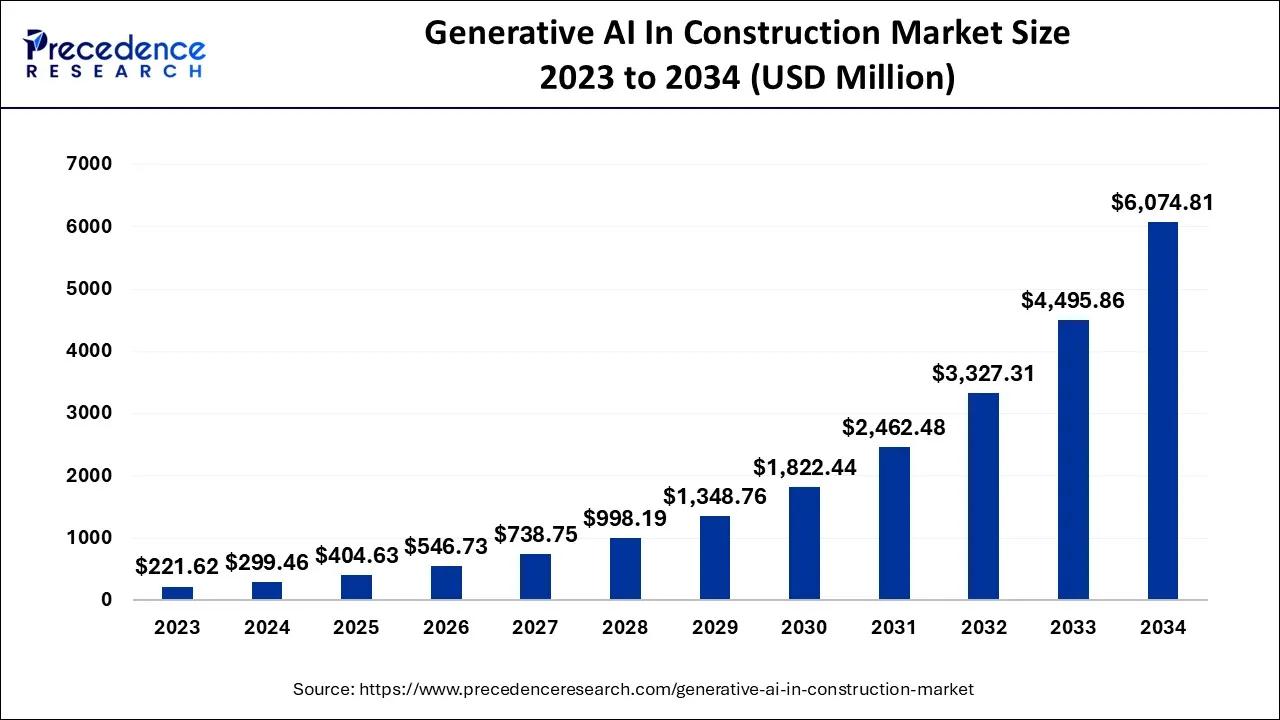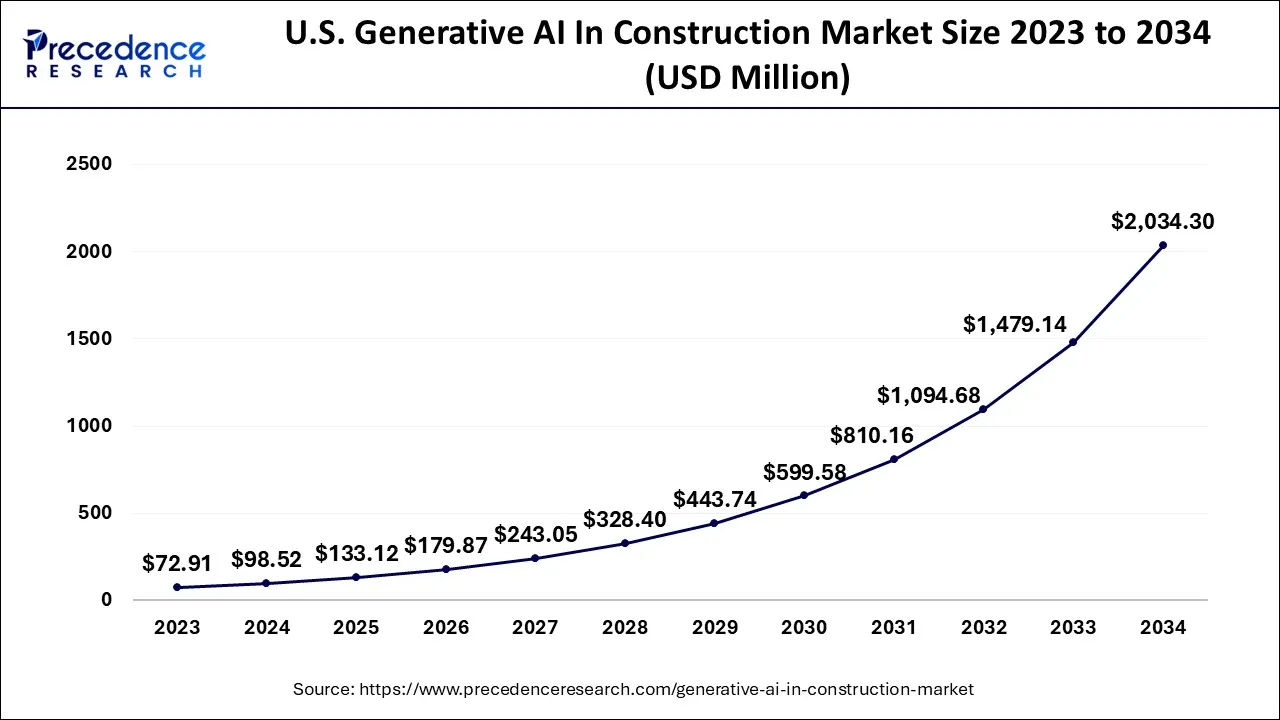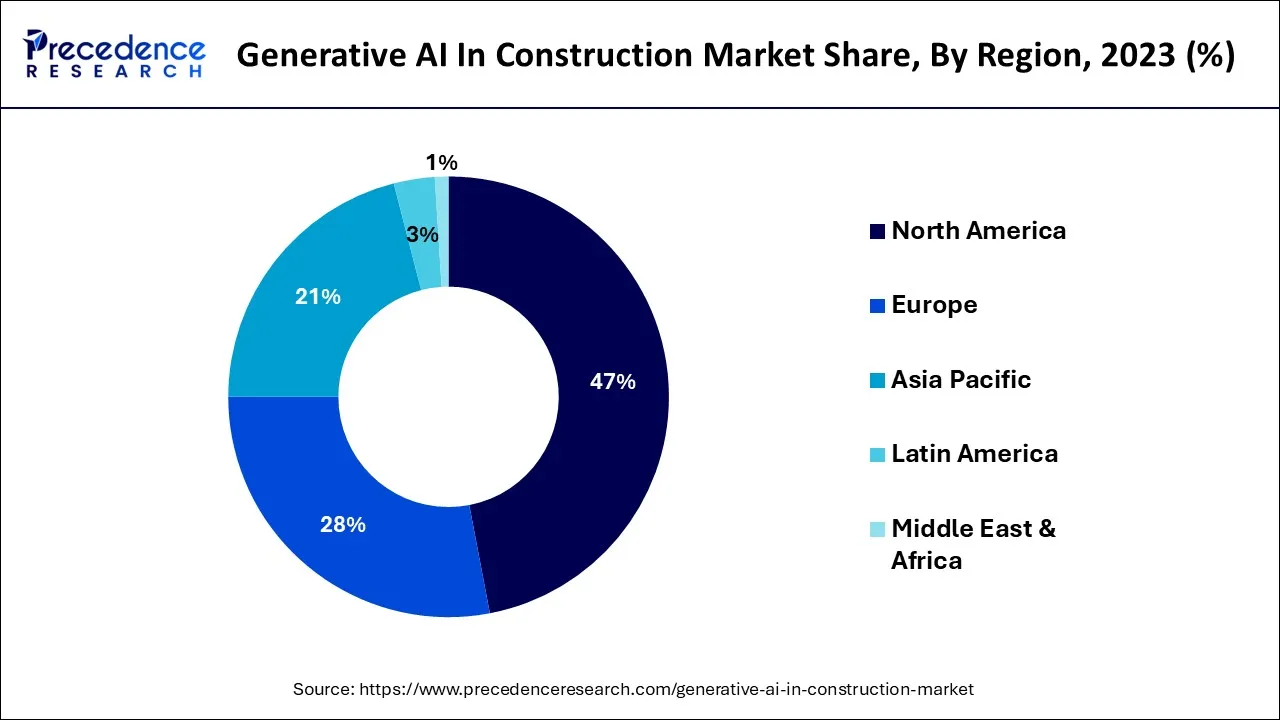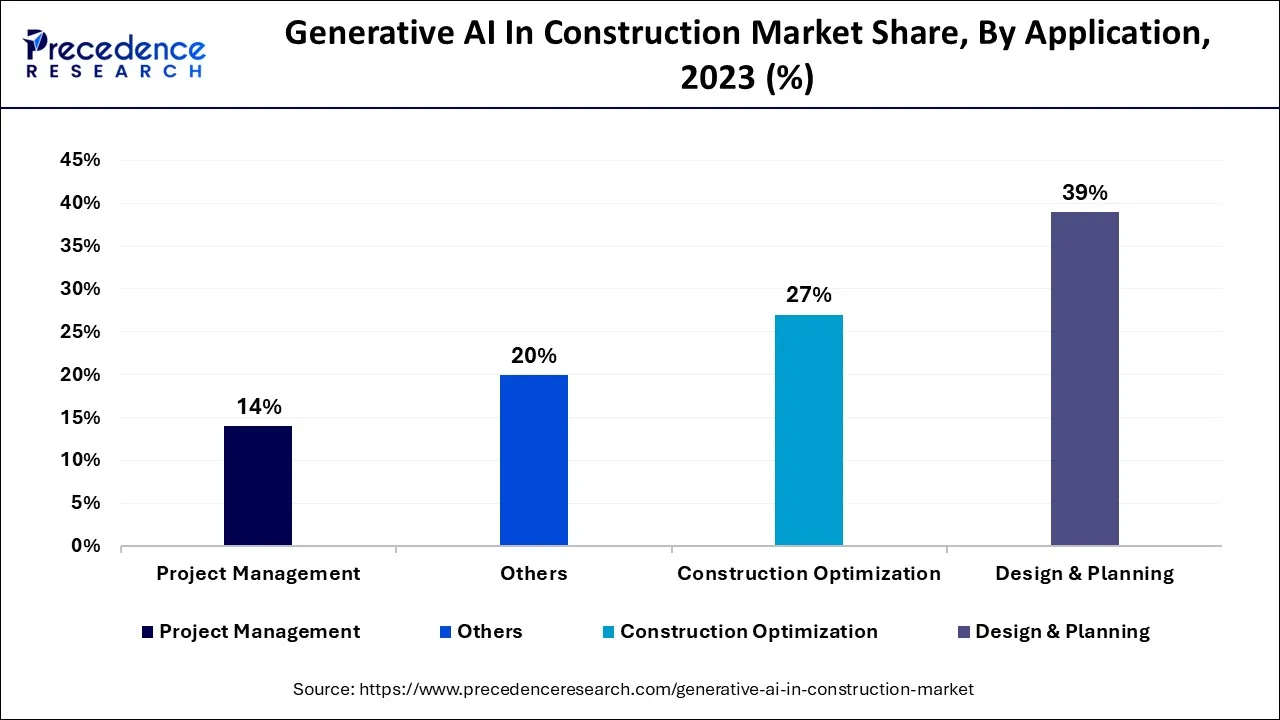Generative AI In Construction Market Size and Forecast 2024 to 2034
The global generative AI in construction market size is calculated at USD 299.46 million in 2024 and is projected to surpass around USD 6,074.81 million by 2034, growing at a CAGR of 35.12% from 2024 to 2034. The market is driven by the rising need for improved productivity and quality control in the construction sector. Moreover, the rising construction of high-rise buildings and focus on sustainability are expected to boost the market growth during the forecast period.

Generative AI In Construction Market Key Takeaways
- North America dominated the global market and contributed more than 47% of revenue share in 2023.
- Europe is expected to witness the fastest CAGR from 2024 and 2034.
- By type, the infrastructure segment is expected to hold the largest market share during the forecast period.
- By technology, the machine learning segment is expected to dominate the market growth over the forecast period.
- By application, the design & planning segment captured more than 39% of the revenue share in 2023 and is expected to dominate the market over the forecast period.
U.S. Generative AI In Construction Market Size and Growth 2024 to 2034
The U.S. generative AI in construction market size is exhibited at USD 98.52 million in 2024 and is projected to be worth around USD 2,034.30 million by 2034, growing at a CAGR of 35.36% from 2024 to 2034.

North America dominated the market with the largest share in 2023. The regional dominance is mainly attributed to its well-developed technology ecosystem and the growing construction industry. North America is at the forefront of technological advancements and research and development of AI technologies. This makes it easier for the construction sector to acquire and incorporate generative AI technology. Increased adoption of technologies, including cloud computing, data analytics, and machine learning, supported the expansion of the generative AI industry in the region.
The region has a thriving construction industry with multiple substantial infrastructure projects, commercial buildings, and residential construction. The industry's requirement for effective project management, cost efficiency, and sustainable practices drove the use of generative AI solutions. Generative AI's capacity to improve decision-making, expedite procedures, and optimize design is in line with the demands of the region's expanding construction industry.

For instance, in 2022, nonresidential expenditure in the United States was estimated to be $888 billion ($534 billion private and $355 billion public). Additionally, the U.S. spent $910 billion on residential construction ($442 billion on single-family homes, $105 billion on multifamily housing, $354 billion on upgrades, and $9 billion on public projects).
Europe is expected to grow at a substantial rate over the forecast period owing to the presence of several market players such as Autodesk, Trimble Inc., RIB Software and others. These companies constantly launch their product, which is expected to penetrate the market expansion in the region. For instance, in May 2023, for improved carbon measurement in construction, RIB Software announced the release of the RIB Carbon Quantifier. To optimize carbon measurement in construction, RIB Software has released the RIB Carbon Quantifier. Building Transparency, a non-profit organization, and RIB Software, a top international provider of cutting-edge technological solutions for the architectural, engineering, and construction (AEC) industry, have teamed together to create the RIB Carbon Quantifier. The program enables users to quickly, simply, and reliably analyze the carbon environmental product declaration (EPD) values.
Market Overview
Artificial intelligence that uses generative techniques may create a variety of material, including text, images, music, and synthetic data. The ease of use of new user interfaces for quickly producing high-quality text, pictures, and pictures has fueled current interest in generative AI.
Construction project design and planning is one of the primary areas where generative AI benefits. Traditional design methods frequently rely on hand-crafted iterations and human imagination, which can be time-consuming and constrained in their ability to explore a broad variety of options. On the other hand, generative AI algorithms can quickly develop and assess a variety of design possibilities based on established parameters, restrictions, and objectives. Having the option to examine several design alternatives enables engineers and architects to find creative solutions that would not have been seen otherwise. In addition, the allocation of resources and building processes may both be optimized with generative AI. Generative models can recognize trends and suggest the best course of action by examining past construction data, including project timelines, prices, and material utilization.
- According to Peak's Decision Intelligence Maturity Index, In 2022, 92% of construction companies said they were using or intended to use AI.
Generative AI In Construction Market Growth Factors
The most effective building schedules, cost-cutting strategies, and alternative material recommendations that support sustainability objectives may all be determined using these models. The need for large-scale project management, cost-based forecasting, and resource and time savings are driving the growth of the worldwide generative AI market in the construction industry. Additionally, it is projected that efficient operations management would promote market growth by lowering expensive errors and workplace accidents.
Market Scope
| Report Coverage | Details |
| Market Size in 2024 | USD 299.46 Million |
| Market Size by 2034 | USD 6,074.81 Million |
| Growth Rate from 2024 to 2034 | CAGR of 35.12% |
| Largest Market | North America |
| Fastest Growing Market | Europe |
| Base Year | 2023 |
| Forecast Period | 2024 to 2034 |
| Segments Covered | By Type, By Technology, and By Application |
| Regions Covered | North America, Europe, Asia-Pacific, Latin America, and Middle East & Africa |
Market Dynamics
Driver
Rising use of generative AI for building design
Building information modeling is a 3D model-based technique that provides architects, engineers, and construction workers with the information they can use to effectively plan, design, build, and manage infrastructure and structures. The architecture, engineering, mechanical, electrical, and plumbing (MEP) plans, as well as the order of the various teams' operations, must be considered in the 3D models when planning and designing a project's construction. Making ensuring that the various models from the various sub-teams do not conflict with one another is the problem. To discover and resolve conflicts between the many models produced by the various teams, the industry leverages machine learning in the form of AI-powered generative design. This reduces the need for rework.
There is software that explores every possible variant of a solution and provides design alternatives using machine learning techniques. The generative design program develops 3D models suited for the limitations when the user enters their needs into the model. Iteratively creating models, it learns from each one until it finds the best one. Thus, this is expected to drive the growth of generative AI in the construction market.
Restraints
Cultural shifts and ethical consideration
A culture shift inside enterprises may be necessary to implement generative AI in construction. Construction industry experts may need to adjust to new working, cooperating, and decision-making processes. The widespread implementation of generative AI in construction may be hampered by organizational buy-in requirements, resistance to change, and a lack of knowledge. Similarly, the use of generative AI in the construction industry raises ethical concerns about the possible effects on employment, intellectual property rights, and prejudice in AI-generated designs. Building credibility and confidence throughout the industry requires addressing these ethical issues and ensuring fair and responsible usage of generative AI technology. Thus, it acts as a major restraining factor for the market growth over the analysis period.
Opportunities
Sustainable construction practices
Green techniques and sustainability are becoming increasingly important in the construction sector. By optimizing designs for energy efficiency, waste reduction, and sustainable material utilization, generative AI may help with sustainable building. Utilizing generative AI to produce eco-friendly design options, suggest eco-friendly materials, and optimize resource utilization presents a chance to meet sustainability objectives and laws. Thus, the advantages of generative AI in sustainable construction practices are expected to offer an attractive opportunity for market development over the projected period.
AI-powered monitoring helps detect pre-issues or errors, reducing maintenance costs. AI-powered analysis helps optimize energy efficiency and ensure sufficient energy consumption. Additionally, generative AI applications like smart information modeling (BIM) help manage resources. Generative AI is significantly helping construction companies promote eco-friendly practices and reduce environmental impacts. AI technologies help monitor construction progress, optimize project workflows, and enhance safety on construction sites.
Type Insights
Based on the type, the global generative AI in the construction market is segmented into residential, commercial, industrial, infrastructure and others. The infrastructure segment is expected to grow at the fastest rate during the forecast period. The segment growth is attributed to the increasing infrastructure investment across the globe. With growing infrastructure projects across the globe, the utilization of AI in infrastructure is growing drastically because of various uses such as design and optimization, structural analysis and risk assessment, process optimization and others. Thereby, driving the segment growth.
Technology Insights
The natural language processing segment is expected to grow rapidly in the coming years. Natural language processing (NLP) enhances communication between stakeholders through voice assistance and AI chatbox for better construction management. It also enables the analysis of construction documents and generates them as per the requirements. Moreover, integrating the NLP algorithm in building information modeling (BIM) helps in data entry, predictive analysis, and risk management. The growing need for enhanced communication is likely to boost segmental growth in the upcoming period.
Application Insights
The construction optimization segment is projected to expand at the fastest rate over the studied period. AI solutions help in project planning, risk management, labor allocation, and resource allocation, ensuring smoother project execution and improving project efficiency. They also ensure efficient use of materials, labor, and equipment and predict resource requirements. In addition, AI detects potential risks as well as reduces environmental impacts. The rising need for effective project management solutions is projected to contribute to the segment's growth.

In addition, over the past several years, a new method for producing the 3D models that construction professionals rely on to precisely plan, build, and repair has emerged. The use of building information modelling enhance construction's capabilities with intelligent, AI-driven features. Toric, a data platform used by engineering, construction, and other industries that allowed anybody to connect, convert, model, and visualize data without writing code, secured USD 22 million in investment in 2022. Toric will offer extra interfaces for Autodesk Construction Cloud and the BIM tools for design from Autodesk, including Revit, and Civil 3D, as part of the investment. Thus, the rise in AI technology investment drives segment growth.
Generative AI In Construction Market Companies
- Autodesk Inc.
- Dassault Systemes
- Trimble
- Bentley Systems
- Katerra
- Oracle Corporation
- Aurora Computer Services
- Building System Planning Inc.
- IBM Corporation
- Microsoft Corporation
Recent Development
- In May 2024, Cemex developed the first generative AI tool of its kind in building material industry, transforming how the salesforce interacts with clients by providing real-time support for a superior customer experience.
- In October 2024, Bentley Systems, Incorporated, the infrastructure engineering software company, introduced new generative AI capabilities for civil site design, including a design copilot, automated drawing production, and site layout optimizations, that will drive new levels of productivity and accuracy.
Segments Covered in the Report
By Type
- Residential
- Commercial
- Industrial
- Infrastructure
- Others
By Technology
- Machine Learning
- Natural Language Processing
- Others
By Application
- Design & Planning
- Construction Optimization
- Project Management
- Others
By Geography
- North America
- Europe
- Asia-Pacific
- Latin America
- Middle East and Africa
For inquiries regarding discounts, bulk purchases, or customization requests, please contact us at sales@precedenceresearch.com
Frequently Asked Questions
Ask For Sample
No cookie-cutter, only authentic analysis – take the 1st step to become a Precedence Research client
 sales@precedenceresearch.com
sales@precedenceresearch.com
 +1 804-441-9344
+1 804-441-9344